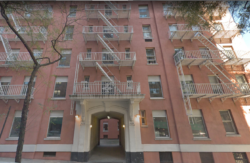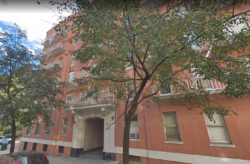
429 East 64th Street. Image credit: Google Maps.
Building owners claimed landmark status caused financial hardship. Stahl York Avenue Co., LLC, tenement development owner of 429 East 64th Street and 430 East 65th Street in the Upper East Side, sued the City and the Landmark Preservation Commission in January 2016, asking the court to release the property landmark status in order to permit demolition and construct new high-rises for larger profits. Stahl York Avenue sought to demolish the two buildings, which are part of six walk up buildings known as “First Avenue Estate,” after claiming financial hardship. The First Avenue Estate, was designated as a landmark in August 1990 by the Commission. In 2007, the Commission approved and adopted resolution to include Stahl York Avenue’s buildings as part of the landmark status. The tenement developments are “light-court” tenements which are designed so that every room in each apartment has natural light from exterior windows, or interior courtyards, which in turn makes the apartments appear larger.
The owners of Stahl York Avenue claimed that the buildings lose about $1 million a year, and are unable to earn a “reasonable return.” In order to bring a hardship claim, party is required to prove that they are unable to earn at least a six percent return. Stahl York Avenue commissioned a study of the associated costs, and claimed between the renovation costs and apartment vacancies, that the estimated annual net return would be negative 2.87 percent. Commission denied the hardship application in May 20, 2014, stating that the anticipated renovation costs was a “self-imposed hardship,” because the owners actively did not re-rent apartments after they became vacant, and therefore found the two buildings were capable of earning a reasonable return.
Stahl York Avenue also claimed that the landmark designation amounted to an “unconstitutional taking.” The takings clause prohibits government taking of private property for public use without just compensation. A per se taking occurs if a regulation deprives the owner of all economically beneficial use of the property.
Stahl York Avenue claimed that the Commission blocked the plan to demolish the buildings and develop high-rise residential structures, resulting in a possible loss of $200 million.

430 East 65th Street. Image credit: Google Maps.
The court analyzed the property interest as a whole and applied a three-factor test to determine whether Stahl York Avenue had a financial hardship claim. The test looks at the regulation’s economic impact, the regulation’s interference with the claimant’s reasonable investment-backed expectations, and the character of the government action.
On May 22, 2018, the court found that Stahl did not meet the standard to establish a governmental taking and found that the First Avenue Estate should be treated as one unified unit. The court stated that the lots are “contiguous” and contained within one city block, and all of the buildings within the First Avenue Estate share a “historical and architectural significance.” Additionally, the court found that the inclusion of the two buildings in the landmark designation did not completely deprive the owners of economically beneficial use, further stating that the buildings in question are capable of a reasonable return.
Despite Stahl’s claim that the Commission was prejudiced against them as the property owners, the court found that the Commission was not arbitrary and capricious in their decision to deny their hardship application to demolish two of its buildings that were within the designated landmark. The court stated the Commission members that approved the plan were appropriately familiar with their regulations, had advanced knowledge of the facts and law surrounding the application, and such decision was in relation to the committed goal for which the commission was created, which is landmarks preservation.
Stahl York Ave. Co. LLC v. City of N.Y., 162 A.D.3d 103 (App. Div. 1st Dep’t May 22, 2018).
By: Samantha Albanese. (Samantha Albanese is a CityLaw intern, and a New York Law School student, Class of 2019).


Please Note: “Fifth Avenue Estate,” is a incorrect name for this landmark. As part of the City and Suburban Homes landmark, it is referred to as the “First Avenue Estate”. As former Chairwoman of the Tenants Association at City and Suburban Homes, York Avenue Estate, we worked tirelessly for decades with Betty Cooper Wallerstein and the Coalition to Save City and Suburban, to successfully landmark both the First Avenue and York Avenue Estates.